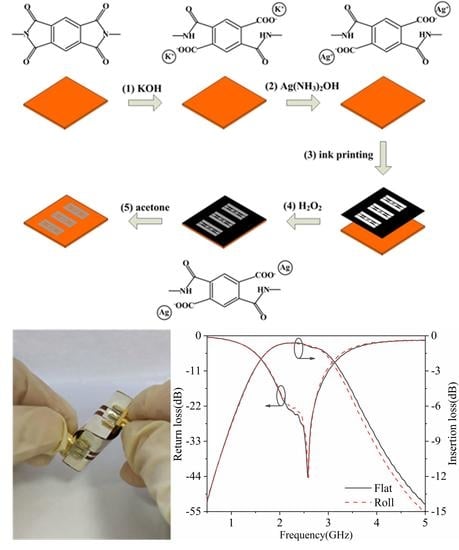Flexible Bandpass Filter Fabricated on Polyimide Substrate by Surface Modification and In Situ Self-Metallization Technique
Abstract
:1. Introduction
2. Materials and Methods
2.1. Design of the Filter
2.2. Fabrication of the Filter
3. Results
3.1. Crystal Structures
3.2. Morphologies
3.3. Characteristics
4. Conclusions
Author Contributions
Funding
Conflicts of Interest
References
- Wu, J.; Wu, Z.X.; Tao, K.; Liu, C.; Yang, B.R.; Xie, X.; Lu, X. Rapid-response, reversible and flexible humidity sensing platform using a hydrophobic and porous substrate. J. Mater. Chem. B 2019, 7, 2063–2073. [Google Scholar]
- Cheng, X.Y.; Wu, J.Y.; Blank, R.; Senior, D.E.; Yoon, Y.K. An Omnidirectional Wrappable Compact Patch Antenna for Wireless Endoscope Applications. IEEE Antennas Wirel. Propag. Lett. 2012, 11, 1667–1670. [Google Scholar]
- Liu, S.Y.; Moncion, C.; Zhang, J.W.; Balachandar, L.; Kwaku, D.; Riera, J.J.; Volakis, J.L.; Chae, J. A fully-passive flexible wireless neural recorder for the acquisition of neuropotentials from a rat model. ACS Sens. 2019. [Google Scholar] [CrossRef]
- Rodrigues, F.; Ribeiro, J.F.; Anacleto, P.; Fouchard, A.; David, O.; Sarro, L.; Mendes, P. Fabrication and characterization of polyimide-based, “smooth” titanium nitride microelectrode arrays for neural stimulation and recording. J. Neural Eng. 2019, 24, 3067–3072. [Google Scholar]
- Shin, J.; Jeong, B.; Kim, J.; Nam, V.B.; Yoon, Y.; Jung, J.; Hong, S.; Lee, H.; Eom, H.; Yeo, J. Sensitive Wearable Temperature Sensor with Seamless Monolithic Integration. Adv. Mater. 2019, e1905527. [Google Scholar] [CrossRef]
- Ma, D.; Wu, X.X.; Wang, Y.G.; Liao, H.; Wan, P.B.; Zhang, L.Q. Wearable, Antifreezing, and Healable Epidermal Sensor Assembled from Long-Lasting Moist Conductive Nanocomposite Organohydrogel. ACS Appl. Mater. Interfaces 2019, 11, 41701–41709. [Google Scholar]
- Han, Y.N.; Liu, Z.H.; Zhang, C.W.; Mei, C.F.; Chen, Q.M.; Hu, K.K.; Yuan, S.Y. A Flexible Microstrip Low-Pass Filter Design Using Asymmetric Pi-Shaped DGS. IEEE Access 2019, 7, 49999–50006. [Google Scholar]
- Pan, T.S.; Dai, L.L.; Chen, S.H.; Yan, Z.C.; Lin, Y. Low-Impedance Flexible Archimedean-Equiangular Spiral Antenna. IEEE Antennas. Wirel. Propag. Lett. 2019, 18, 1789–1793. [Google Scholar]
- Park, J.; Park, S.; Yang, W.; Kam, D.G. Folded aperture coupled patch antenna fabricated on FPC with vertically polarised end-fire radiation for fifth-generation millimetre-wave massive MIMO systems. IET Microw. Antennas Propag. 2019, 13, 1660–1663. [Google Scholar]
- Yang, T.; Yu, Y.Z.; Zhu, L.S.; Wu, X.; Wang, X.H.; Zhang, J. Fabrication of silver interdigitated electrodes on polyimide films via surface modification and ion-exchange technique and its flexible humidity sensor application. Sens. Actuators B Chem. 2015, 208, 327–333. [Google Scholar]
- Wu, R.X.; Fang, X.M. A Novel Primary-Embedded On-Chip Transformer for 6-kV-Isolation High-Efficiency DC–DC Conversion. IEEE Electron Device Lett. 2019, 40, 586–588. [Google Scholar]
- Chen, B.L.; Kruse, M.; Xu, B.; Tutika, R.; Zheng, W.; Bartlett, M.D.; Wu, Y.; Claussen, J.C. Flexible thermoelectric generators with inkjet printed bismuth telluride nanowires and liquid metal contacts. Nanoscale 2019, 11, 5222. [Google Scholar]
- Sirringhaus, H.; Kawase, T.; Friend, R.H.; Shimoda, T.; Inbasekaran, M.; Wu, W.; Woo, E.P. High-Resolution Inkjet Printing of All-Polymer Transistor Circuits. Science 2000, 290, 2123–2126. [Google Scholar]
- Lin, Y.; Huang, L.; Chen, L.; Zhang, J.; Shen, L.; Chen, Q.; Shi, W. Fully gravure-printed NO2 gas sensor on a polyimide foil using WO3-PEDOT: PSS nanocomposites and Ag electrodes. Sens. Actuators B Chem. 2015, 216, 176–183. [Google Scholar]
- Khaleel, H.R. Design and fabrication of compact inkjet printed antennas for integration within flexible and wearable electronics. IEEE Trans. Antennas Propag. 2014, 4, 1722–1728. [Google Scholar]
- Wu, Z.P.; Wu, D.Z.; Qi, S.L.; Zhang, T.; Jin, R.G. Preparation of surface conductive and highly reflective silvered polyimide films by surface modification and in situ self-metallization technique. Thin Solid Film. 2005, 493, 179–184. [Google Scholar]
- Wu, Z.P.; Wu, D.Z.; Yang, W.T.; Jin, R.G. Preparation of highly reflective and conductive metallized polyimide films through surface modification: Processing, morphology and properties. J. Mater. Chem. 2006, 16, 310–316. [Google Scholar]
- Wang, Z.L.; Qin, L.; Chen, Q.Y.; Yang, W.W.; Qu, H.W. Flexible UWB antenna fabricated on polyimide substrate by surface modification and in situ self-metallization technique. Microelectron. Eng. 2019, 206, 12–16. [Google Scholar]
- Zhu, L.; Huamin, S.; Menzel, W. Coupling behaviors of quarter-wavelength impedance transformers for wideband CPW bandpass filters. IEEE Microw. Wirel. Compon. Lett. 2005, 15, 13–15. [Google Scholar]
- Jiang, Y.; Zhao, Y.; Zhang, L. Flexible Film Bulk Acoustic Wave Filters toward Radiofrequency Wireless Communication. Small 2018, 14, 1703644. [Google Scholar]
- Sans, M.; Selga, J.; Vélez, P.; Bonache, J.; Rodríguez, A.; Boria, V.E.; Martín, F. Compact Wideband Balanced Bandpass Filters with Very Broad Common-Mode and Differential-Mode Stopbands. IEEE Trans. Microw. Theory Tech. 2018, 66, 737–750. [Google Scholar]
- Zhao, M.; Zhang, Y.; Liu, S.; Jia, Y. UWB flexible filter with low loss and excellent stopband performance. Microw. Opt. Technol. Lett. 2017, 59, 194–197. [Google Scholar]
- Zhao, M.; Zhang, Y. Compact wearable 5-GHz flexible filter. Electron. Lett. 2017, 53, 661–663. [Google Scholar]
- Li, R.; Guo, Y.X.; Chen, W. A flexible liquid-metal alloy bandpass filter. Int. J. RF Microw. Comput. Aided Eng. 2018, 28, e21265. [Google Scholar]
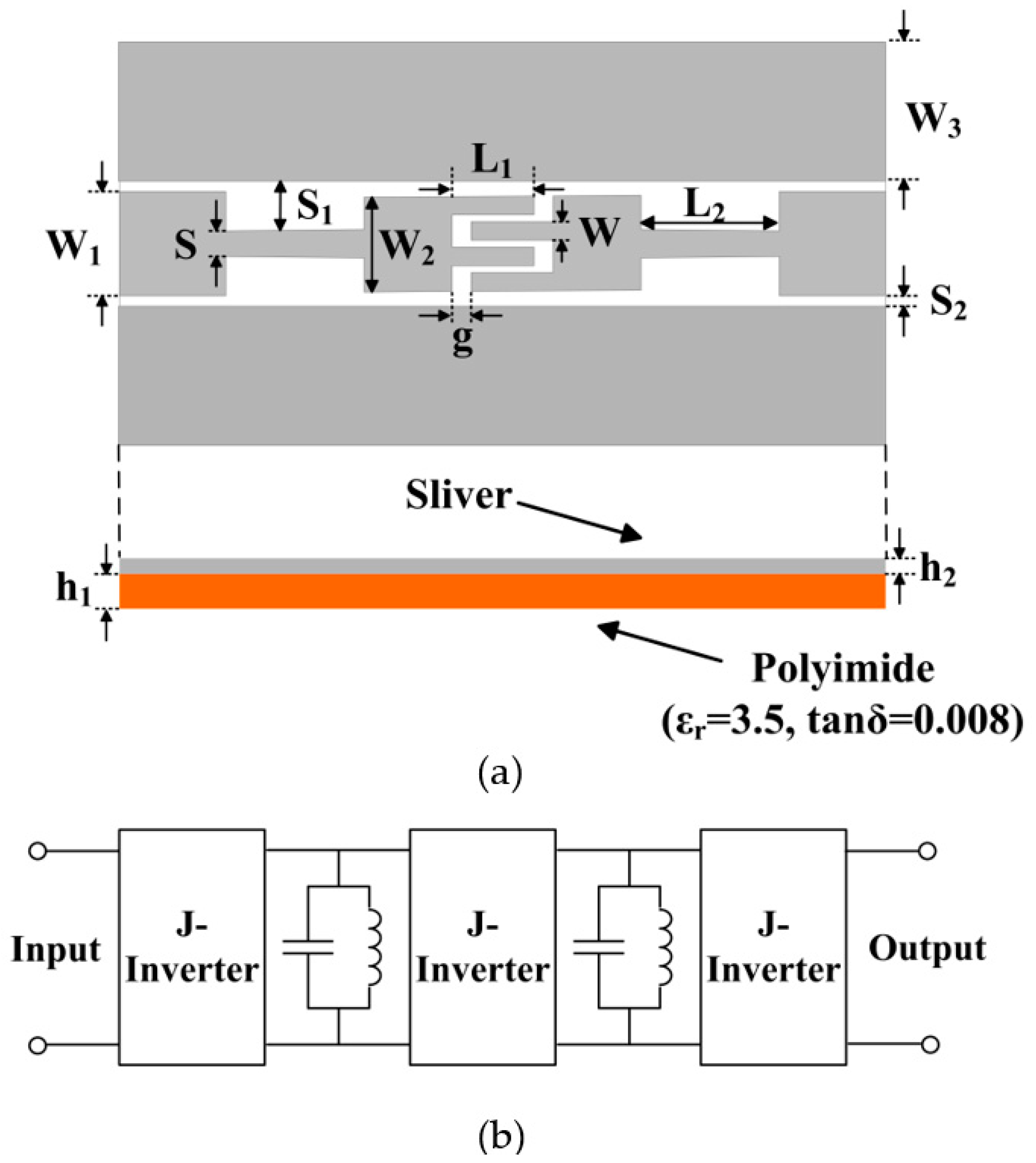


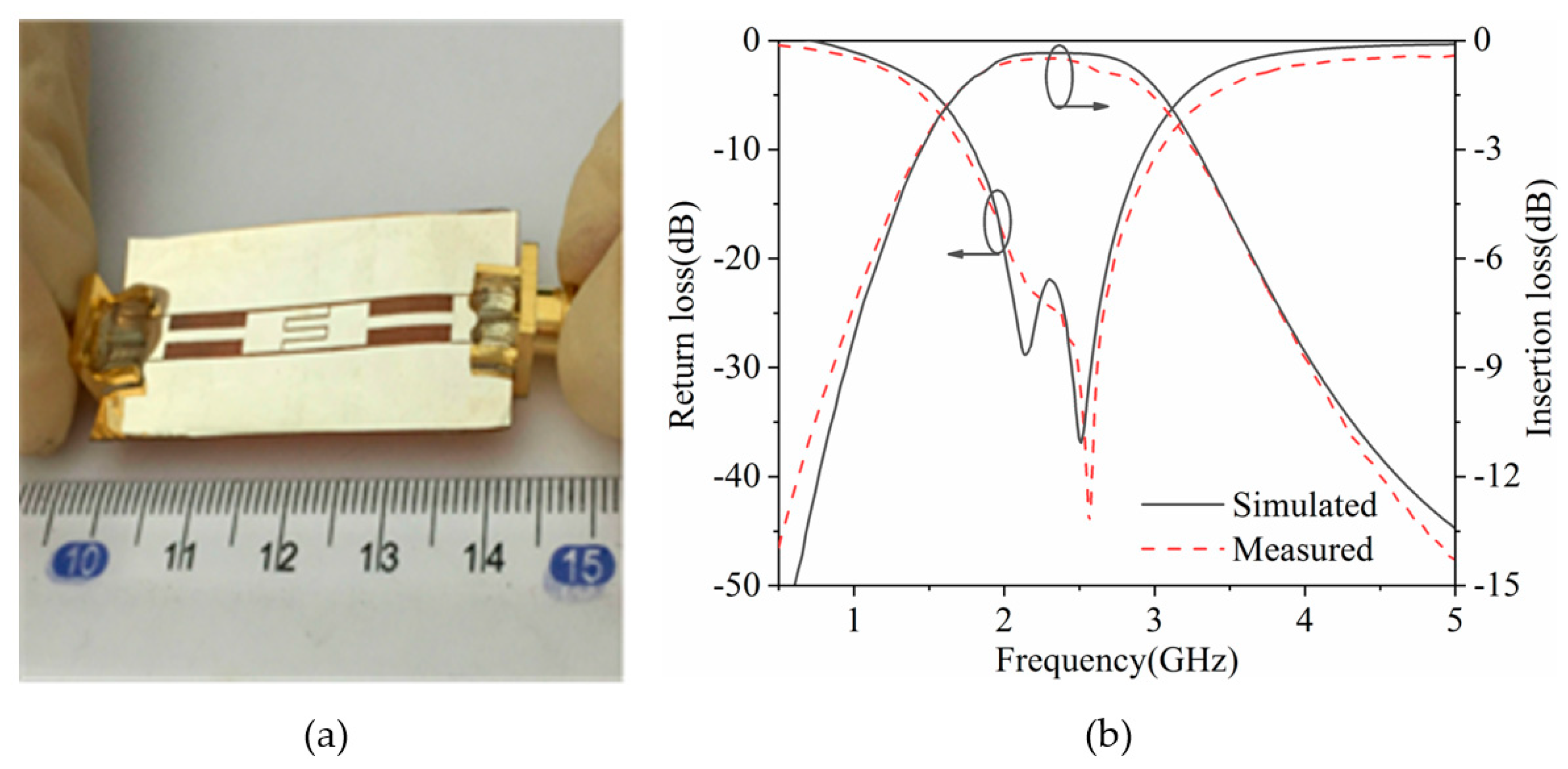

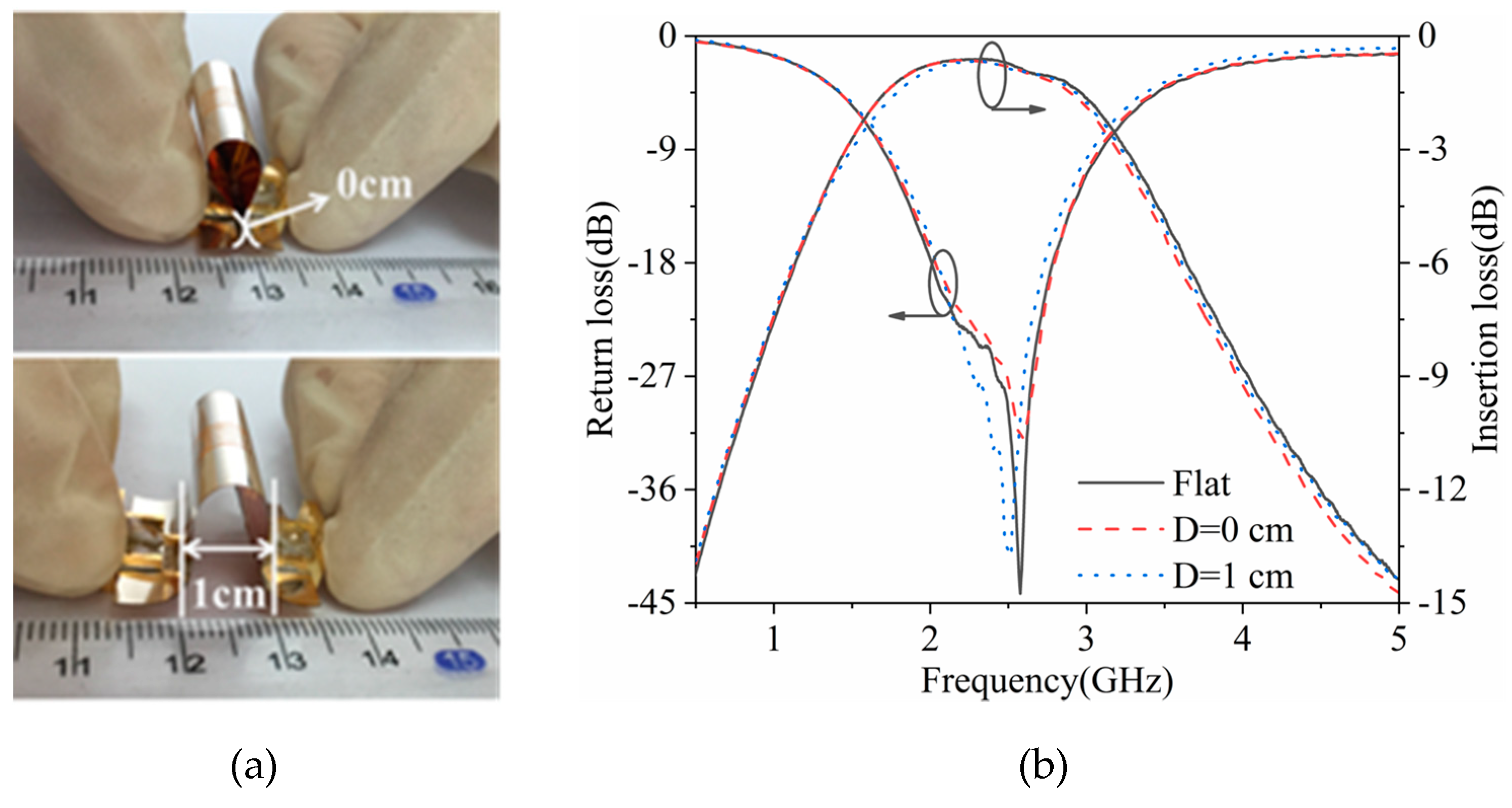
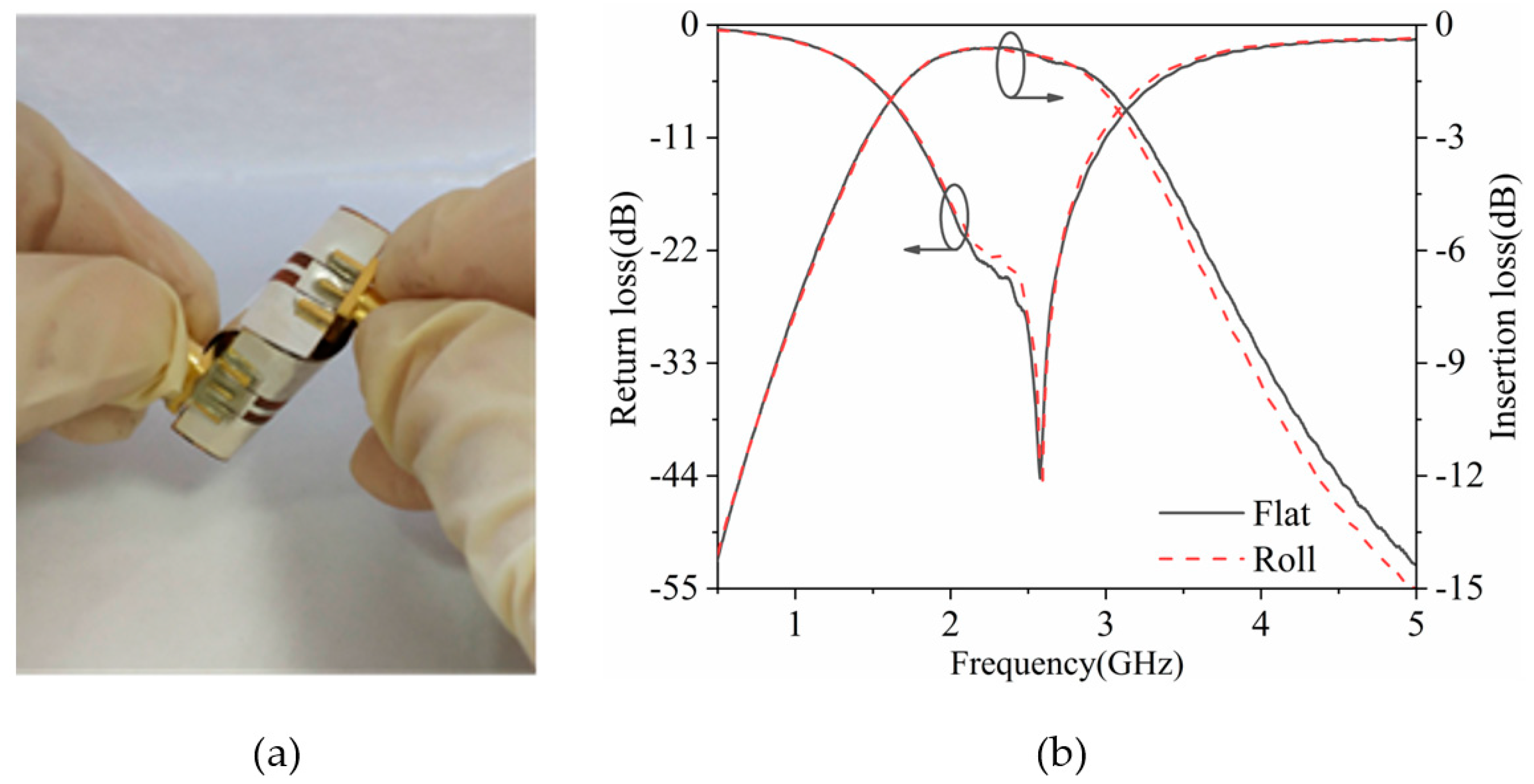
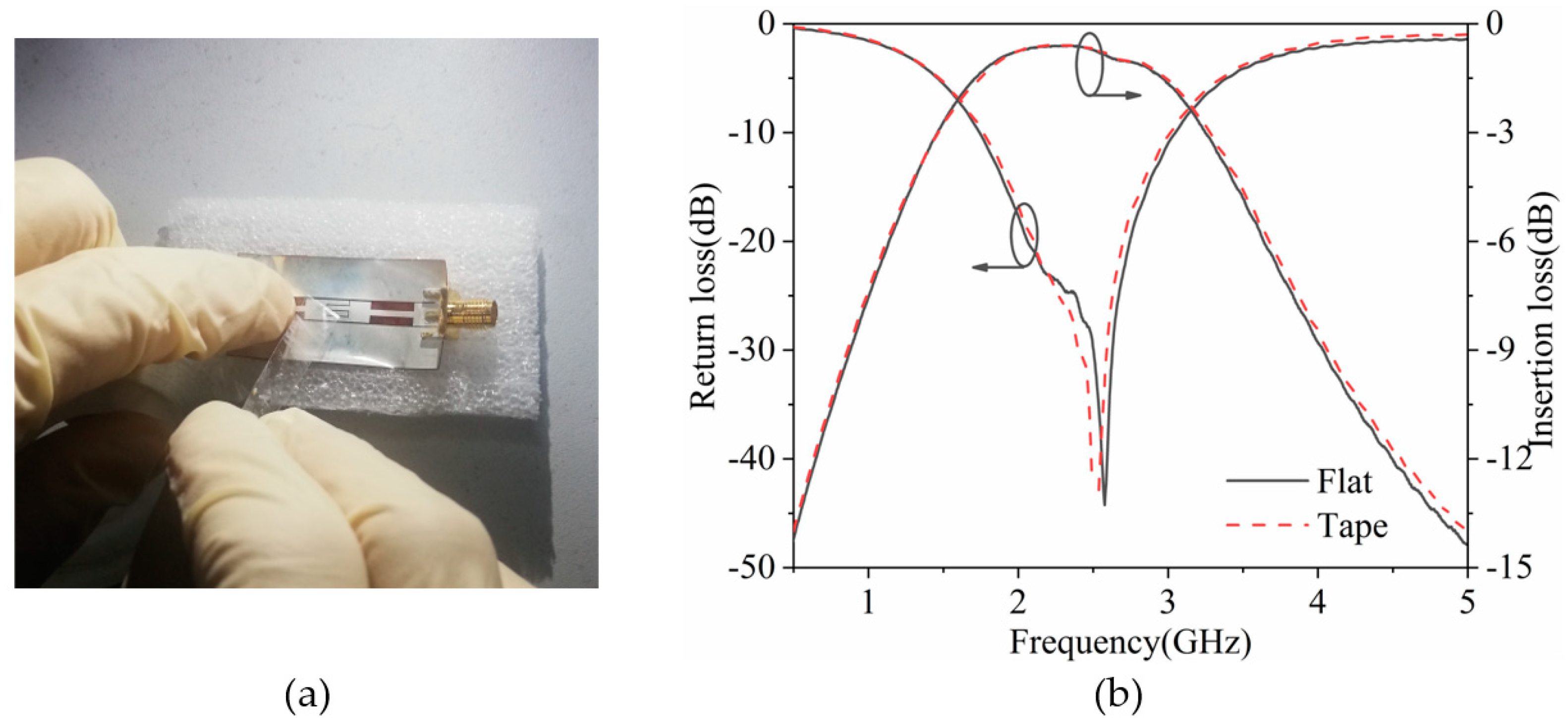
| Fabrication Method | Center Frequency (f0) (GHz) | Minimum Insertion Loss (|S21|) (dB) | Ref. | ||||||||
|---|---|---|---|---|---|---|---|---|---|---|---|
| Flat | Bend | Fold | Roll | Tape | Flat | Bend | Fold | Roll | Tape | ||
| Printing | 7.35 | 7.20(45) 1 | NA 2 | NA | NA | 0.80 | 0.80(45) | NA | NA | NA | [22] |
| 5.53 | 5.61(37) | NA | NA | NA | 1.9 | 2.03(37) | NA | NA | NA | [23] | |
| Photolithography | 2.48 | 2.48(15) | NA | NA | NA | 1.59 | 1.59(15) | NA | NA | NA | [24] |
| In this work | 2.42 | 2.42(60) | 2.42 | 2.42 | 2.42 | 0.49 | 0.50(60) | 0.51 | 0.51 | 0.51 | |
© 2019 by the authors. Licensee MDPI, Basel, Switzerland. This article is an open access article distributed under the terms and conditions of the Creative Commons Attribution (CC BY) license (http://creativecommons.org/licenses/by/4.0/).
Share and Cite
Qu, H.; Wang, Z.; Cang, D. Flexible Bandpass Filter Fabricated on Polyimide Substrate by Surface Modification and In Situ Self-Metallization Technique. Polymers 2019, 11, 2068. https://doi.org/10.3390/polym11122068
Qu H, Wang Z, Cang D. Flexible Bandpass Filter Fabricated on Polyimide Substrate by Surface Modification and In Situ Self-Metallization Technique. Polymers. 2019; 11(12):2068. https://doi.org/10.3390/polym11122068
Chicago/Turabian StyleQu, Huiwen, Zhiliang Wang, and Dingyong Cang. 2019. "Flexible Bandpass Filter Fabricated on Polyimide Substrate by Surface Modification and In Situ Self-Metallization Technique" Polymers 11, no. 12: 2068. https://doi.org/10.3390/polym11122068
APA StyleQu, H., Wang, Z., & Cang, D. (2019). Flexible Bandpass Filter Fabricated on Polyimide Substrate by Surface Modification and In Situ Self-Metallization Technique. Polymers, 11(12), 2068. https://doi.org/10.3390/polym11122068






